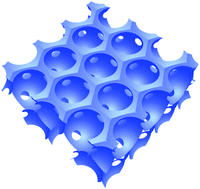Inverse opal scaffolds for applications in regenerative medicine
Abstract
Three-dimensional porous scaffolds are indispensable for regenerative medicine owing to their roles in providing physical supports and adjustable microenvironments for cells to attach, stretch, migrate, proliferate, and differentiate. In order to fulfill these roles, an ideal scaffold must possess certain properties such as appropriate pore size, porosity, and interconnectivity, among others. To this end, porous scaffolds with an inverse opal structure emerged. Unlike other scaffolds that are fabricated by stochastic porogen methods with random structures, an inverse opal scaffold is characterized by uniform and finely tunable pores and interconnecting windows, in addition to their highly reproducible structure among different batches of production. In this opinion article, we start with an analysis of the motivation for using the inverse opal scaffolds and an introduction to the fabrication method. We then highlight the advantages of such porous scaffolds over their counterparts with non-uniform structures through side-by-side comparisons. Finally, we offer some perspectives on the future directions, after discussions of two examples on the unique applications of the inverse opal scaffolds in regenerative medicine.


 Please wait while we load your content...
Please wait while we load your content...